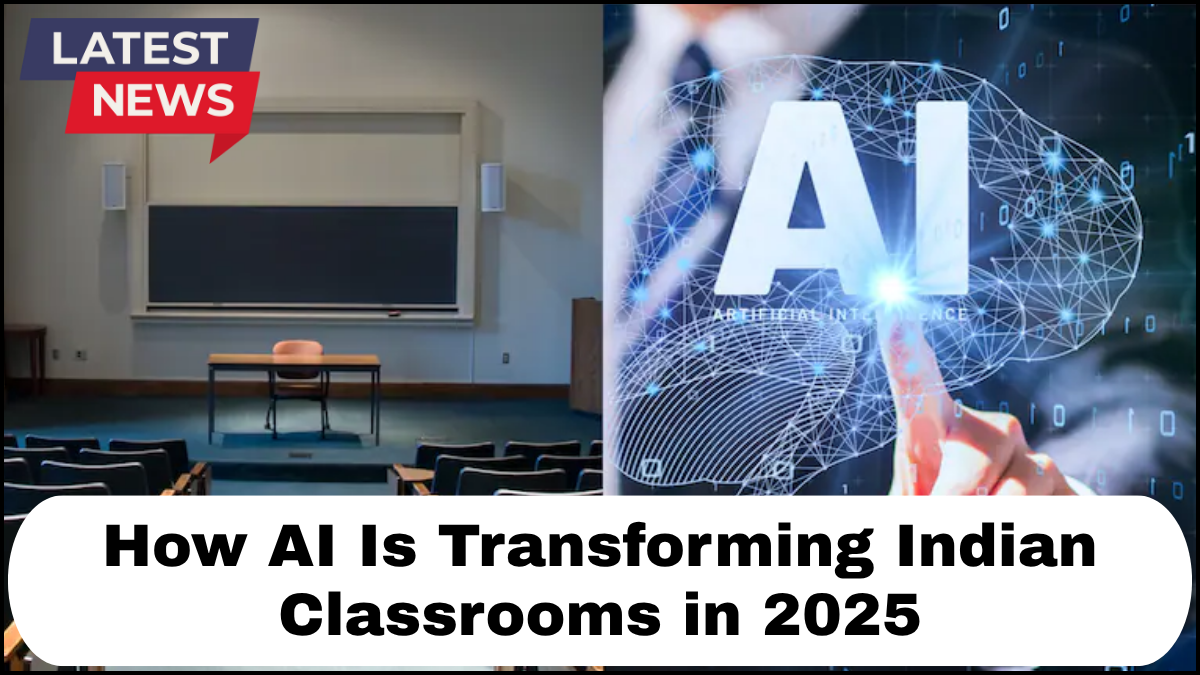The Indian education system is undergoing a radical shift. In 2025, AI in Indian Classrooms is no longer a futuristic concept—it’s the new standard. From rural government schools to elite urban institutions, artificial intelligence is reshaping how students learn, how teachers teach, and how schools function. The integration of digital learning tools powered by AI is making education more personalized, efficient, and inclusive than ever before.

Personalized Learning at Scale
Traditional teaching methods often adopt a one-size-fits-all approach, but AI changes that. AI systems in Indian classrooms are analyzing individual student data to tailor content, pace, and difficulty level. Tools like adaptive learning platforms track students’ progress in real-time and adjust lesson plans accordingly.
For example, a student in a government school in Uttar Pradesh struggling with fractions gets customized exercises and instant feedback, while another student excelling in geometry gets access to advanced problems. This dynamic personalization ensures no student is left behind and each learner progresses at their optimal pace.
Smart Classrooms with Real-Time Insights
AI-powered smart classrooms are becoming increasingly common. These setups include facial recognition for attendance, voice-activated systems for interactive lessons, and AI-driven analytics that provide teachers with real-time feedback on student engagement.
For instance, if a majority of students appear distracted during a math lesson, the AI system alerts the teacher and suggests an alternative explanation or interactive method. This level of responsiveness was unthinkable just a few years ago and is now helping educators respond faster and more effectively.
Revolutionizing Assessments and Feedback
Assessment is another area where AI in Indian classrooms is making a significant impact. Automated grading tools are saving teachers hours of manual work, allowing them to focus more on teaching and mentoring. More importantly, AI doesn’t just assign grades—it provides diagnostic insights.
Instead of just telling a student they got a question wrong, AI tools now explain why the answer was incorrect, offering hints or revisiting relevant concepts. This instant, targeted feedback boosts retention and encourages deeper understanding.
Breaking Language and Accessibility Barriers
India’s linguistic diversity has long posed challenges in education. AI is bridging these gaps through real-time translation and voice synthesis. Students can now access textbooks and classroom instructions in their preferred regional language, thanks to natural language processing (NLP) tools.
Additionally, AI is making classrooms more inclusive for students with disabilities. Voice-controlled interfaces, screen readers, and AI-based sign language interpreters are enabling equal participation for all learners.
Empowering Teachers with AI Co-Pilots
AI isn’t replacing teachers; it’s empowering them. Teachers are now using AI-driven digital learning tools to plan lessons, generate quizzes, and even predict which students may need extra support.
For example, an AI assistant might highlight that a student has been underperforming in science for two weeks, prompting the teacher to provide one-on-one help. These tools help teachers become more proactive and informed in their decision-making.
Boosting Digital Infrastructure in Rural India
One of the most powerful outcomes of AI in Indian classrooms is its ability to shrink the urban-rural education divide. With government initiatives pushing for greater digital infrastructure and affordable internet, even schools in remote villages are now equipped with AI-enabled digital learning tools.
Projects like DIKSHA (Digital Infrastructure for Knowledge Sharing) have incorporated AI to curate personalized learning paths for students based on their performance. This democratization of quality education is a game-changer for India’s future workforce.
Challenges and the Road Ahead
Despite the progress, challenges remain. Data privacy, teacher training, and infrastructure gaps in remote areas still need attention. However, with policy support from the National Education Policy (NEP) and increasing public-private partnerships, the momentum is strong.
The key will be to ensure AI tools remain ethical, inclusive, and aligned with educational goals—not just tech trends.
Frequently Asked Questions (FAQs)
Q1. How is AI different from traditional digital learning tools in Indian classrooms?
AI tools adapt and personalize content in real-time based on student performance, whereas traditional tools offer static content without customization.
Q2. Can AI replace teachers in Indian classrooms?
No. AI is designed to assist, not replace, teachers. It handles administrative tasks, provides insights, and offers personalized content, but human connection and guidance remain irreplaceable.
Q3. Is AI being used in rural schools in India?
Yes. Initiatives like DIKSHA and partnerships with edtech companies are bringing AI-based digital learning tools to rural areas, helping bridge the urban-rural education divide.
Q4. What are the risks of using AI in education?
Potential risks include data privacy concerns, algorithmic bias, and over-reliance on technology. Ensuring transparency and proper training can mitigate these issues.
Q5. How does AI help in language diversity across Indian classrooms?
AI-powered translation and NLP tools convert lessons into regional languages, helping students understand content in their native tongue.
click here to learn more